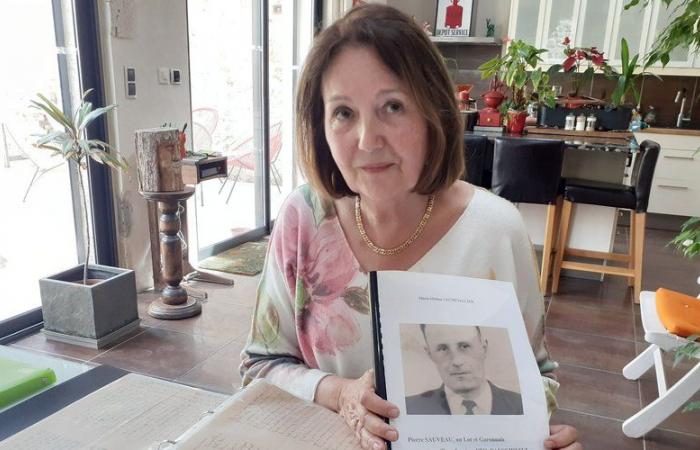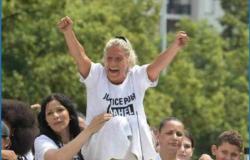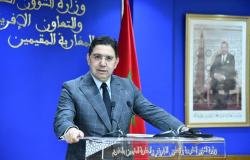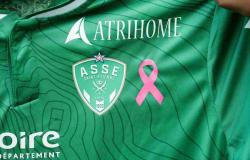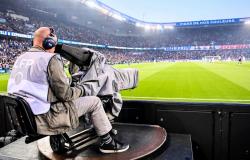the essential
Recently discovered letters are an exceptional testimony to the experiences of these young Lot-et-Garonnais requisitioned by the Germans between 1943 and 1945.
Goddaughter of a former teacher and college principal in Castelmoron-sur-Lot (Pierre Sauveau, born in 1920 and died in 1996), Marie-Hélène Lechevallier carried out fascinating research work on her godfather, who was a victim of STO during the Second World War.
Originally from Castelmoron, high school student in Villeneuve-sur-Lot then student at the Pau normal school, Pierre Sauveau was forced to take the train from Casseneuil on March 10, 1943. After stops in Agen then Paris, he found himself in Germany then in Poland, in the camp of the French assigned to the construction of the Buna factory, located in the Auschwitz concentration camp.
Marie-Hélène Lechevallier found 51 letters written by her godfather between April 1943 and January 1944, letters subject to censorship and addressed to her family in Lot-et-Garonne. The work carried out on these archives resulted in a historical study of some 150 pages, and the author has written this summary.
“On March 16, 2013, an article in La Dépêche du Midi reported the conditions for the departure for the STO on March 10, 1943 of some 754 Lot-et-Garonnais. This article recalled that the Compulsory Labor Service (STO) had been established by the coercive law of February 16, 1943 of the French State of Vichy for young people born in 1920, 1921 and 1922.
Some 650,000 young French people were sent to forced labor in Nazi Germany. Recently 51 letters sent from Auschwitz to his family by Pierre Sauveau between May 1943 and January 1944 were found. It is the exceptional testimony of a young man during this terrible period in our 20th century history. Pierre Sauveau narrates in the present the facts, the emotions, the day-to-day experience and its impact on lives.
Born in June 1920 in Castelmoron-sur-Lot, he was part of the first STO convoy departing from Casseneuil. This Lot-et-Garonnais convoy arrived 2 or 3 days later in Oppeln in occupied Poland. This town is the Upper Silesian marshalling yard for the captive labor that the Nazis took from all over Europe. He was sent with 2,500 other French forced laborers to the Auschwitz labor camp. Student teacher, which is to say “good for nothing” in this world of labor exploitation, the work card issued to him upon his arrival indicates that he will be employed as a construction worker.
Together with prisoners and deportees from the Auschwitz III-Monowitz concentration camp, French STOs worked on the construction of the immense IG Farben factory intended to produce rubber and synthetic gasoline. Pierre Sauveau is assigned to earthworks: “My work absorbs a lot of me. He forces me to get up at 3:15 a.m., leave at 3:30 a.m. and arrive at the construction site in the middle of the night at 4:30 a.m. […] my nights are short,” he wrote on October 9, 1943.
Confronted with a world that censorship did not allow him to describe, on November 18, 1943, he confided: “I wonder what rut our poor country has fallen into and if it will ever be able to get out of it. Seeing so much villainy makes our hearts move.” On November 20, 1943, he added: “If we are in hell, this hell is earthly and we hope to return.” This hope of return torments him. In this nagging wait, shared values allow us to hold our heads high: “We celebrated our July 14 holiday with dignity, calmly, with our flag and our national song. On this foreign land it gave us an immense pleasure of which those who are in France cannot imagine,” he wrote to his parents on July 17, 1943.
Finally, in mid-January 1945, Allied bombings combined with the advance of the Red Army forced Himmler to evacuate all the concentration and work camps in the East. On January 21, 1945, in the evening, columns of young forced laborers from the STO left Auschwitz, supervised by German soldiers. Pierre Sauveau recounted this departure in a poem written on March 1, 1945:
“In the middle of the night, sinister and dark,
In a thrill of hazardous terror,
The order finally came: leave or die,
Go hang out somewhere else, without talking!
The ball of exile, hunger and misery,
On the snowy road, harsher than an ordeal!
And in the darkness, the long convoy of wanderers,
Staggering under the weight of the crushing burden,
Went elsewhere, overwhelmed with sadness. »
With his companions in misfortune, he covered some 250 km on foot in 10 days, in the snow and the freezing winter. Finally by train, 800 French STOs from Auschwitz reached Dresden on February 6 and were directed to Königstein, about twenty kilometers south of Dresden. On February 13, the terrible bombardment of this city took place. Several tens of thousands of residents died there. French STOs will be used to clear the rubble; the SS will burn the bodies of the deceased for five weeks, explained Geert Mak in 2004 in his book “Journey of a European through the 20th century”. “Vision of hell”, writes Pierre Sauveau in one of his poems. Finally, faced with the defeat of the Reich, the local German administrative hierarchy, no longer taking orders from Berlin into account, organized the return of the STOs to France.
On April 28, 1945 Pierre Sauveau was entrusted with 43 sick people, including two children, unable to walk, to transport them by train to Karlsbad, where they were liberated by the Americans.
Back in France Pierre Sauveau was a committed, passionate and recognized teacher. He was appointed academic palm officer at the age of 50. But marked by his years as an STO, his life was forever darkened. Died in 1996, he did not have the opportunity to know the outcome of the long legal battle led by the STO alumni associations. Finally, by decree of October 16, 2008, the official designation of “victims of forced labor in Nazi Germany” was recognized.

